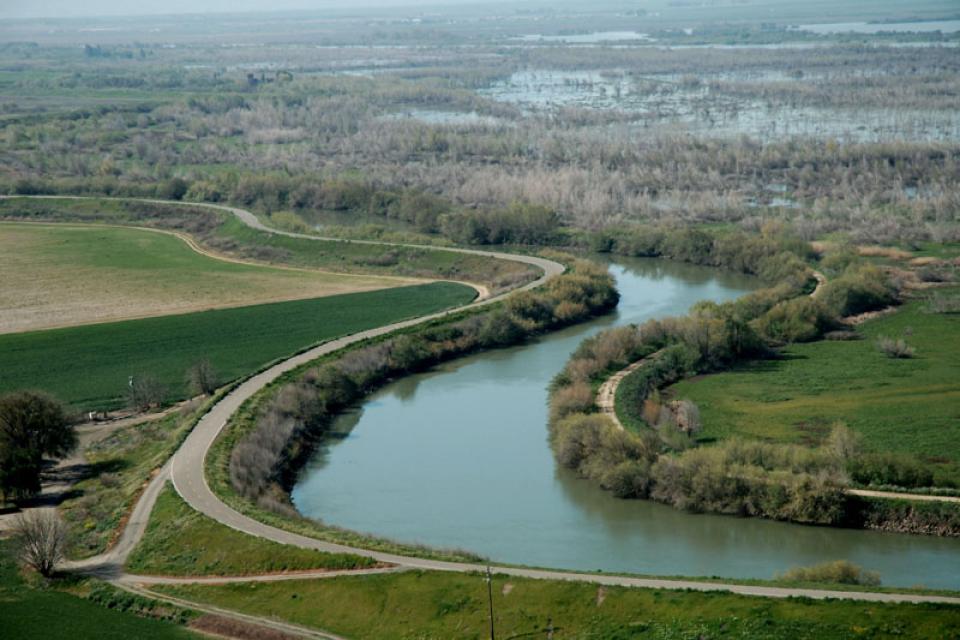Sacramento-San Joaquin Delta Proposals
There are multiple proposals for the Sacramento-San Joaquin Delta underway, though a decision on the future of the Delta is still far from a foregone conclusion.
Unlike past planning efforts that focused primarily on water resource issues and the ecosystem, some current efforts to revitalize the Sacramento-San Joaquin Delta include:
- land use planning
- recreation
- flood management and energy
- rail and transportation infrastructure
How— or if—all these competing demands can be accommodated is an open question.
There are several proposals in place. [See also Sacramento-San Joaquin Delta timeline.]
The Bay Delta Conservation Plan
The Bay Delta Conservation Plan is a permitting process for the Sacramento-San Joaquin Delta that centers on co-equal goals of species conservation and improving water supplies and delivery.
The BDCP aims to separate its water delivery system from Delta freshwater flows and restore thousands of acres of habitat, restore river flows to more natural patterns and address issues affecting the health of fish populations.
As part of the water conveyance, in 2013, California Gov. Jerry Brown also proposed constructing two $25 billion tunnels to divert Sacramento River water underneath the Delta and then deliver the water to the Central Valley and Southern California.
If approved, the BDCP would be implemented over the next 50 years and construction of the tunnels would not begin for another 10 to 15 years.
The BDCP aims to separate its water delivery system from Delta freshwater flows and restore thousands of acres of habitat, restore river flows to more natural patterns and address issues affecting the health of fish populations.
As part of the water conveyance, in 2013, California Gov. Jerry Brown also proposed constructing two $25 billion tunnels to divert Sacramento River water underneath the Delta and then deliver the water to the Central Valley and Southern California.
In 2014 the 8,000-page-plus environmental review document was released.
If approved, the BDCP would be implemented over the next 50 years and construction of the tunnels would not begin for another 10 to 15 years.
Delta Plan
The Delta Plan is a comprehensive management plan for the Sacramento San Joaquin Delta intended to help the state meet the coequal goals of water reliability and ecosystem restoration.
The Delta Stewardship Council oversees the Delta Plan. A final version of the plan was approved in 2013.
Stressing levee maintenance and conservation, the plan aims to improve statewide water reliability while maintaining a healthy ecosystem and balancing the needs of various Sacramento-San Joaquin Delta stakeholders.
Once completed, the Bay Delta Conservation Plan could be incorporated into the Delta Plan.
Sacramento-San Joaquin Delta Vision Process
Legislation and a governor’s executive order signed in September 2006 initiated the Delta Vision Process, which built on work done through CALFED (a collaborative state-federal effort that, aimed to protect the Sacramento-San Joaquin Delta and provide water to urban and agricultural interests).
The Delta Vision approach encompassed the Delta’s full array of infrastructure and land use resources. It also set a strategy for managing the Delta as a sustainable ecosystem that can support its environmental and economic functions.
The Delta Vision organizational structure was highlighted by a “blue ribbon” task force of policy and resource experts informed by a 42-member stakeholder coordination group whose final recommendations were forwarded to five agency secretaries – dubbed the Delta Vision Committee.
The Schwarzenegger administration’s Delta Vision Implementation Committee released a list of “fundamental actions” in December 2008. Included in the list is the so-called “Peripheral Canal,” which while designed to safeguard the integrity of water exports, is quite controversial because of concerns about its size, scope, cost and environmental impacts.
Sacramento-San Joaquin Delta Risk Management Strategy/DRMS
Overseen by the California Department of Water Resources, California Department of Fish and Wildlife and the U.S. Army Corps of Engineers, the Delta Risk Management Strategy considers the sustainability of the Delta and assess major risks from floods, seepage, subsidence and earthquakes, sea level rise and climate change. DRMS also evaluates the consequences and develops recommendations to reduce and manage the risk.
Overall, the Delta Risk Management Strategy aims to define flood control benefits and beneficiaries within and outside of the Delta, while bringing together various stakeholders. DRMS also helps guide levee upgrades and provides experts to answer technical questions that guide policy. As a result, both policy and science will be components of the visioning process.









